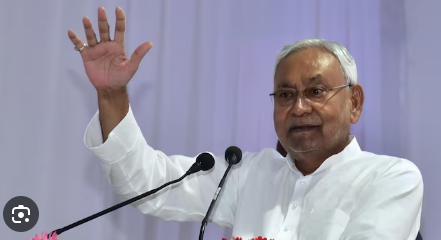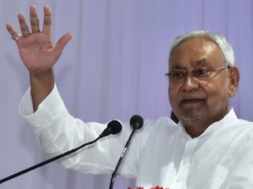
Manas Dasgupta
NEW DELHI, Nov 7: The Bihar chief minister Nitish Kumar has proposed to break the reservation cap of 50 Per cent set by the Supreme Court and take the total quota limit in government jobs and admissions in educational institutions to 75 per cent, including the 10 per cent reservation decided by the Centre for the Economically Weaker Sections while scrapping the existing three per cent quota for OBC women.
Kumar on Tuesday proposed that the reservation for Scheduled Castes and Scheduled Tribes, as well Other Backward Classes and Extremely Backward Classes, to 65 per cent, besides the centre’s 10 per cent reservation for the EWS. The proposals will take state quotas past the 50 per cent cap set by the Supreme Court in 1992.
“The 50% (reservation) should be increased to at least 65%… The upper caste has 10% already (EWS). So 65 and 10 make 75%. The remaining would be 25%. Earlier, 40% was free now it would be 25%. The reservation for backward class and extreme backward class, ST-SC should be done 65% instead of 50%, this is my proposal,” he said in the state Assembly.
“We will do the needful after due consultation. It is our intent to effect these changes in the current session,” the Chief Minister said.
Under the proposed revised quotas, Scheduled Caste candidates will have 20 per cent reservation, while those from OBCs and EBCs will get 43 per cent quota – a significant increase from the earlier 30 per cent. Reservation of two per cent has been proposed for ST candidates. The current reservation levels are 18 per cent for EBCs and 12 per cent for Backward Classes, 16 per cent for Scheduled Castes, and one per cent for Scheduled Tribes.
Mr Kumar made the proposal soon after the report on the economic condition of 215 Scheduled Castes, Scheduled Tribes, Backward Classes and Extremely Backward Classes – were presented in the Assembly on Tuesday afternoon.
According to the report, second set of data from the Bihar government’s caste-based survey, a third – 34 per cent – of all families in Bihar survive on less than ₹ 6,000 per month, and 42 per cent of Scheduled Castes and Scheduled Tribes households live in poverty. Only 5.76 per cent of Scheduled Castes had finished Class 11 and Class 12. That number rises just marginally to nine per cent for all; this is significantly lower than six per cent listed in a 2017/18 National Statistical Office report.
The report comes amid allegations by Union Home Minister Amit Shah that the Bihar government inflated the population of the Yadav and Muslim communities. Both the Deputy Chief Minister Tejashwi Yadav and the state Parliamentary Affairs Minister Vijay Kumar Chaudhary have rubbished Shah’s allegations.
The first set of data was released last month and said over 60 per cent of Bihar hails from Backward or Extremely Backward Classes, and over 20 per cent come from Scheduled Castes or Scheduled Tribes. Overall, according to the Bihar caste survey, 36 per cent of the state’s 13.1 crore people are from EBCs, 27.1 per cent are from Backward Classes, and 19.7 per cent are from Scheduled Castes. Scheduled Tribes make up 1.7 per cent of the population, and the General Category is 15.5 per cent.
The overall data from the Bihar government’s report is worrying. It states that 34.13 per cent of all families in the state earn up to a paltry ₹ 6,000 per month and 29.61 per cent survive on ₹ 10,000 or less. It also states that nearly 28 per cent live on income between ₹ 10,000 and ₹ 50,000, and only less than four per cent earn over ₹ 50,000 per month.
The report paints a grim picture – particularly in a state where those from marginalised communities and backward classes constitute over 80 per cent of a population of more than 13.1 crore.
Overall, 42.93 per cent of families from Scheduled Castes and 42.70 per cent from Scheduled Tribes have been listed as poverty-stricken. Among Backward and Extremely Backward Classes, this number is 33.16 per cent and 33.58 per cent. Among other castes, 23.72 per cent of all families are poor.
Only 25.09 per cent of General Category families are listed as poor. Within this, 25.32 per cent of Bhumihars, 25.3 per cent of Brahmins, and 24.89 per cent of Rajputs are listed as poor. Brahmins and Rajputs account for 7.11 per cent of Bihar’s population. The Bhumihars are 2.86 per cent. Among Backward Classes, 35.87 per cent of Yadavs – Deputy Chief Minister Tejashwi Yadav belongs to this community – are poor, as are 34.32 per cent of Kushwahas and 29.9 per cent of Kurmis.
Those earning a living in other states number around 46 lakhs while 2.17 lakhs have moved abroad. Those pursuing studies in other states number 5.52 lakhs while 27,000 are studying on foreign shores.
The Yadavs constitute 14.26 per cent of the population and they are the largest OBC sub-group, while the other account for a little over eight per cent of the total. On average, over 30 per cent of EBC families are poor. It is 29.87 per cent among Telis, rising to 32.99 for Kanus, 34.08 for Chandravanshis, 34.75 for Dhanuks and 35.88 for Noniyas.
The overall literacy rate in the state is 79.7 per cent, according to Mr Chaudhary. “In our survey, literacy rate is 79.70 per cent. Literacy rate is higher in women (compared to) men…for every 1,000 males, there are 953 (literate) females,” he said. For context, he said this number was 918 in 2011.
Only 22.67 per cent of respondents had studied till Class 5, but this increases to 24.31 per cent for people from Scheduled Castes and 24.65 per cent for those from Extremely Backward Classes. Among the General Category this is just 17.45 per cent. Only 5.76 per cent of those surveyed from Scheduled Castes had completed schooling; i.e., Class 11 and 12. This improved marginally to nine per cent for all respondents.
Demands for a nation-wide caste census have gathered steam since Bihar’s August survey, with the issue becoming a political hot potato in the run-up to elections in five states – Chhattisgarh, Telangana, Rajasthan, Madhya Pradesh, and Mizoram – this month and the 2024 Lok Sabha poll.
The BJP – at the centre – has, in the past, been reluctant to back this demand, but Amit Shah indicated an about-face in that policy this week. He said his party had never really opposed the exercise but would only carry out a survey after due diligence. After the release of the first tranche of Bihar data, Prime Minister Narendra Modi had, in an event in poll-bound Madhya Pradesh, hit out at those “trying to divide the country in the name of caste”.
The Congress has been clear on its position; it will hold a survey in states it wins in this month’s polls and Rahul Gandhi said it will also be held at a national level should the party win next year.
The Bihar government’s caste survey – now a political hot potato after the opposition has pushed for a similar, nation-wide exercise – began to make headlines in November last year. The court called the quota – introduced shortly before the 2019 Lok Sabha election – non-discriminatory and said it does not alter the basic structure of the Constitution.














